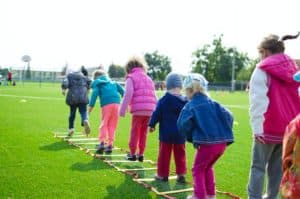With time, trends and norms evolve to suit the ever-progressing world. This is true for every life process, including schools.
Therefore, a concerned parent will always keep up with the changing school trend.
This ensures that their wards do not miss any educational benefits children their age enjoy.
Children are the future of any society. Therefore, proper education of children of every age should be the priority of every setting.
Providing adequate information on the expected age of their wards at each school grade, from kindergarten to high school, will guide parents, teachers, and guardians as they train these young ones.
Following kindergarten, they enter the first year of primary school, called grade one or 1st grade.
How Old Are You in 1st Grade?
The first grade is the first school year of a child after Kindergarten and preschool. When your children start kindergarten, it seems surreal.
Then the first year of primary school comes, and you have lots of work. These grades can be challenging for your ward.
But, careful planning helps relieve some of the pressure.
The minimum age at which most schools admit graders to elementary school is 6 years old, but an exceptionally bright child can be accepted at 5 years old.
This way, when in middle school, the student is between 11 -14 of age.
Thus, peers are in the same grades, and the child’s grade corresponds to their age.
Graders in the United States start high school at 17 and 18 years old. High school starts in 12th grade, which is the end of middle school.
And following this sequence, they can join the workforce or advance in learning at an excellent age.
In other states, there are slight variations, but this is the typical school age in any clime.
Children start school at the minimum age of 5-7 years old and should be through high school at 17-18 years of age.
Following guidelines is essential to ensure that children in the same age group move together in the same school grade.
Starting school with those of the same age helps to curtail feelings of inferiority and bullying among students.
In the Netherlands, Group 3, the third year of basic school, corresponds to first grade. Children in Russia enter перший клас, which is the equivalent of 1st grade.
In Russia, when students enter первый класс, they are between 6-8 years of age.
Children in Ukraine who are between the ages of six and seven begin first grade.
The first year of school in England and Wales is referred to as reception, and the students there are between 4 and 5 years old. So, in some climes the ideal age of a first grade student is 5 years old.
In Ireland, how old are you in 1st grade? The equivalent is called First Class or Rang a haon in Ireland. As this is the third year of school, students are typically 6-7 years old.
So, how old are you in 1st grade? Your child can be 5 years old in first grade, with the furthest age being 7 years old.
The student is enrolled in elementary school depending on their disposition to learning and assimilation.
The First Grade: An Overview
In Kindergarten, teachers guide children through basic concepts. They teach for short periods and use engaging colors and pictures to explain concepts.
Therefore, the first grade is a game changer. When children enter first grade, they must stay indoors for extended periods.
It is also exciting as they balance class and outdoor activities. They also have to learn new science, math, and reasoning ideas.
However, parents must know that academic excellence is independent of age. Moreover, even for slow learners, love can help them blossom into academic scholars.
The child interacts with cultural concepts in the first grade and learn communication skills.
Then, they move from learning words to piecing sentences together and having knowledge of numbers to arithmetic problems.
At the end of the first grade of elementary school, they should have crossed the following milestones:
1. Motor Skills
They develop these physical skills as they interact with other graders and teachers and have skills such as:
- Neater and legible handwriting
- Hand-eye coordination
- Sports and races
- They are taught to do mundane things such as tying shoelaces and zipping clothes
- Right use of cutleries and eating utensils
- Carrying out simple chores
- Copy letters and recognize shapes
By the third year of elementary school, these skills are well developed.
2. Cognition
When students resume in September, they are taught several new concepts during the first grade.
In addition, they begin to ask many questions as they try to grasp these concepts. By the start of the second year, they
- Logical reasoning and critical thinking
- Improved writing skills
- Can read familiar words and make sensible sentences
- Have trouble making choices between two similar objects
- Have a great sense of time and changing seasons
- Can predict patterns
3. Communication and Language
The children may be able to communicate using long sentences. They may say difficult things, which make little sense at the beginning of the first grade of primary school.
However, by the end of first grade, they may merge written sentences with their speeches.
In first grade, you should expect the first grade student to:
- Communicate their wants, needs, and preferences
- Convince people about their views
- Tell unending stories using the things around them
- Stop reversing letters when writing
4. Social Skills
Elementary school students need a consistent balance of attention, validation, and independence.
When they feel constricted, they become aggressive and obstinate. They may also:
- Independent but insecure in themselves. They need frequent approval from guardians and adults
- Begin to understand embarrassing situations
- Get hurt easily and are aware of the feelings of others
- Competitive and critical
- Can make friends easily
- Learn the concept of being polite
5. Emotion and Control
Children learn to control their emotions as they pass through the first grade.
At 6 years old, they start to understand their actions and the effects of wrongdoing. They may also:
- Be unwilling to accept new concepts
- Be hurt by criticism or punishment
- Become more introverted or extroverted depending on the attitude of their guardians
- Start to embrace education and have emotional ties to teachers
How to prepare a child for 1st grade?
Kindergarten, which is the beginning of the child’s education path, is finally over, and it is time to introduce your child to a new school year. This time, it is first grade.
The typical school year starts in September, and the child must meet the age requirements to be enrolled.
Before September, parents must make inquiries about the cut off date to ensure that their wards begin the term with students in other grades.
Most children have to adapt to the changes of 1st grade. It will help to lay ground rules for school from when they start kindergarten.
This eases them into the 1st grade when they are starting school.
The United States formally starts school in September and accepts children aged 6-7 into elementary school.
Although 1st grade is a fun class, all children grow and cope differently.
As a parent, here are helpful tips to ease your child’s way through their first year in elementary school:
1. Keep a Positive Attitude
Taking care of a child, especially one in 1st grade, may be tiresome. They may subject you to critical thinking as they ask overwhelming questions.
Listening to a 1st grade student’s chatter as you pack their lunch or walk them to the park may also become annoying.
Sometimes, your child may be slow in catching up on concepts. Do not get worried, as it is quite normal for seven year olds to be in 1st grade.
You may have to put in extra effort, but guiding your child as they learn is always a worthwhile venture.
If they are too nervous and self-conscious in a given year, it is best to skip the year.
Many states accept late entry into elementary school. Or the student can be enrolled in the next school year.
2. Be Involved in their Learning Process
Although your child has learned basic mathematical concepts in Kindergarten, they will need to know harder ones in first grade.
It will help if you are by their side, teaching and working on problems with them.
You can help them with complex words as they read their favorite stories.
It will also help to make games out of learning, such as spelling drills before snacks and fun mathematical games as you take walks or long drives.
This will help them be comfortable with the concepts the 1st grade has in stock.
3. Learn with Them
At the start of kindergarten, the child learns to interact with others who are 5-7 years old. But, with time, you must teach them socially acceptable norms.
Label household items to aid your child in identifying items with their names. Take a ton of index cards.
Schools enroll children of averagely 6 years old. In this first year, they should start to understand complicated things in this grade, and associate objects with their names.
Create an index card playground in your house.
Working with your first grader, find each item on the index card. Gradually increase the challenge and reward them when they get it right.
4. Be a Constant Guide
Reading and writing are both parts of literacy. Because they are closely related, teachers place these concepts together when teaching children in 1st grade.
A child practices segmenting words into smaller parts and distinguishing each letter’s sounds in kindergarten.
(This process is called decoding), they may need help with complex problems. Answer their questions patiently
This is so because first-graders should understand the alphabet and the fundamentals of letters and words. They frequently possess the ability to identify and provide rhymes.
These abilities help those in 1st grade learn words and ease book reading.
The education system stipulates that the typical age group of children in 1st grade should be between 5-7 years old.
The age requirements ensure that the child is a good writer who can communicate knowledge in various formats.
Drawing, writing letters and words, listening to others, and speaking aloud all fall under this category.
In this education system, 1st grade students engage in activities such as:
- Identifying and writing capital and lowercase letters.
- Rhyming, matching letters to sounds, and word recognition without sounding out some syllables (teachers refer to these as sight words, and some of the first ones kids pick are and, the, and it).
- Conveying thoughts, feelings, and ideas, learning new words, and employing them.
- Discuss the characters, places, and critical events in a narrative the instructor has read aloud, and ask and answer questions about them.
- In a photograph, identify the subject, setting, object, or concept.
- Maintaining a line of thought when speaking
Pro Tip
By illustrating, discussing, and writing about an event, a subject, or a viewpoint, you can impart information to your first grader.
Please participate in group reading and writing exercises with your child.
It is not too early to start a study group (for example, read a big picture book aloud and let your child and other 6-7 year olds share their ideas about it).
First grade students will have problems adapting to the new reading patterns. It will help if you prepare them for study.
You can also provide treats and other rewards.
5. Familiarize them with Class Rules
Help them become accustomed to the policies and expectations of a primary school. Talk to your kids about school-related topics every day.
Teach them how to behave in class, such as maintaining classroom discipline, asking for permission to speak in front of the class or leave, lining up to attend classes, standing up to greet the teachers, etc.
Children can learn various skills in 30 to 45 minutes, including correctly drawing, coloring, writing letters, and sitting.
It also helps to introduce them to students in other grades. Children aged 5-7 years are impressionable and will learn to do what they see other graders do.
6. Make a reliable Routine
If you do not establish a reliable schedule before classes begin, the start of the school year will come as a rude awakening.
Start waking your child up earlier, designate an afternoon study period, and make sufficient time each day for working with them. Start now, not tomorrow!
7. Develop their Confidence
When children enter kindergarten, they do not understand what competition means.
All they do is have fun. But, in higher grades, they become self-aware and may be prone to bullying or feelings of inadequacy.
At this time, they are 5 years old, sometimes 6 years old, and need a constant boost of confidence as they navigate this first class.
You must give attention to these young ones and help them find confidence in themselves.
See related posts:
- 3 Year Old Hitting At Preschool
- Should Kids Have Homework in Elementary School?
- Can 4 Year Olds Read
Conclusion
First-graders are in the foundational primary school years, and it is now simple to determine a child’s age from their grade.
This primary education is crucial in the child’s formative years.
Sticking to the age requirement ensures that your child is always in the right class and moves along with others of the same age in learning.
For children, first grade serves as a transitional year. This first class sets your child up for the remainder of their academic career.
Most students might be a little curious, which could explain why they inquire about complicated things whenever they can.
With an excellent primary education, they transition into middle school and high school with ease.
The dream of every parent from when their kids start kindergarten is that the children become high-achieving students in all grades from elementary school to high school.
Parenting is no easy task at any level, but it is well worth it in the end!

Iesha is a loving mother of 2 beautiful children. She’s an active parent who enjoys indoor and outdoor adventures with her family. Her mission is to share practical and realistic parenting advice to help the parenting community becoming stronger.





